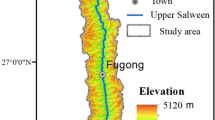Abstract
Integrated disaster mitigation needs interpreting torrent catchment areas as complex landscape systems. The history of valley-evolution shows the influence of climate and vegetation on the valley-evolution.
The energy-concept (energy dissipation concept including the idea of the energy-line) is used for a simple explanation of debris flow. Examples of heavy debris flow disasters in controlled torrents in the Alps and Pyrenees give hints, which expanding the time scale can show that side-effects restrict or counteract the mitigation measures. A pallet of different mitigation measures to avoid or to reduce some of the side-effects is shown. The comprehensive method of disaster mitigation also includes the effect of vegetation. The pallet includes: avoiding hazards (hazard mapping, warning and alarming), appropriate land use and avoiding disaster-enhancing measures in the landscape and technical measures, which take into account their side-effects. The energy line is used as simple design theory. The Jiu-Jitsu Principle is explained too. With this comprehensive method a more sustainable reduction of disasters seems possible.
Similar content being viewed by others
References
Ahl, V., Allen, T.F.H. 1996. Hierarchy Theory — A Vision, Vocabulary, and Epistemology, New York, Columbia University Press, pp. 206
Arbeitsgemeinschaft Fliessgewässer, 1989. Vergleich der ökologischen Qualität einer begradigten und einer mäandrierenden Strecke am Oichtenbach (Salzburg); Natur und Landschaft 65(11): 517–523. (In German)
Aulitzky, H. 1970. Der Enterbach (Inzing in Tirol) am 26. Juli 1969, Versuch einer Analyse eines Murganges als Grundlage f ür die Neuerstellung einer zerstörten Wildbachverbauung, Wildbach-und Lawinenverbau 34(1): 31–66. (In German)
Bless, R. 1981. Untersuchungen zum Einfluss von gewässerbaulichen Maßnahmen auf die Fischfauna in Mittelgebirgsbächen; Natur und Landschaft 57(7/8) (In German)
Blumenstein, O., Schachtzabel, H., Barsch, H., Bork, H.R., Küppers, U. 2000. Grundlagen der Geoökologie, Erscheinungen und Prozesse in unserer Welt, Berlin, Heidelberg, New York, Springer. Pp. 260. (In German)
Erismann, Th. H., Abele, G. 2001. Dynamics of Rockslides and Rockfalls, Berlin, Heidelberg, New York, Springer-Verlag. Pp. 316
Heim, A. 1932. Bergsturz und Menschenleben; Fretz & Wasmuth Verlag, Zürich. (In German)
Hitsch, R., Weinmeister, H. W., 1992. The flow of energy by realisation of different methods of construction in torrent control; Interpraevent 1992 — Bern, fol. 4. Pp. 279–290
Intergovernmental Panel on Climate Change (IPCC), http://www.grida.no/climate/ipcc/regional/112.htm
Joshi, J., Majtán, St., Morita, K., Omura, H. 2000. Landslide hazard mapping in the Nallu Khola watershed, Central Nepal. Jour. of Nepal Geological Society 21: 21–28
Jungwirth, M. 1998. Skriptum zur Vorlesung „Allgemeine Hydrobiologie“, Universität für Bodenkultur Wien. Pp. 101. (In German)
Jungwirth, M., Winkler, H. 1983. Bedeutung der Flussbettstruktur für Fischgemeinschaften, ÖEWW 359/10: 229–234 (In German)
Karl, J., Danz, W. 1969. Der Einfluss des Menschen auf die Erosion im Bergland, Schriftreihe der Bayerischen Landesstelle für Gewässerkunde. München 1., München. (In German)
Kellerhals, P., Studer, J., Indermühle, M. 1992. Führer für die Exkursion E3 Gürbe und Aare, Interpraevent 1992, Bern. (In German)
Körner, H. 1975. Reichweite und Geschwindigkeit von Bergstürzen und Fließlawinen, Manuskript, Bayr. Geologisches Landesamt, München. Pp. 32. (In German)
Körner, H.J. 1976. Reichweite und Geschwindigkeit von Bergstür rzen und Fließschneelawinen; Rock Mechanics 8(4) 225–256. (In German)
Körner, H.J. 1983. Zur Mechanik der Bergsturzströme vom Huascaran, Peru. Hochgebirgsforschung H. 6, Innsbruck. Pp. 71–110. (In German)
Laatsch, W. 1977. Calculation of Avalanche Velocities I and II. Forstw. Cbl. 96, 221–289 and 338–348.
Laatsch, W. 1978. Die statistische Ermittlung extremer Reichweiten von Fließlawinen; Mitt. Forstl. Bundesversuchsanstalt 125: 153–175. (In German)
Laatsch, W. 1980. Vorschlag zu einer statistischen Berechnung der Reichweite von Fließlawinen, Interpraevent 1980 3: 111–124 (In German)
Laatsch, Zenke B., Dankerl J. 1981. Verfahren zur Reichweiten-und Stoßdruckberechnung von Fließlawinen; Forstl. Forschungsberichte München 47/1987, 125. (In German)
Länger, E. 2003. Der forsttechnische Dienst für Wildbach-und Lawinenverbauung in Österreich und seine Tätigkeit seit der Gründung im Jahre 1884, Dissertation an der Universität für Bodenkultur, Wien. (In German)
Majtán, S., Omura, H., Joshi, J. 2000. Dependency of shallow landslides on geometric parameters and its potentiality; J. Fac. Agr., Kyushu Univ 44(3–4), 445–453
Nachtnebel, H.P., Debene, A. 2005. Endbericht Abflussanalyse Donau und Traisen. Im Auftrag der Niederösterreichischen Landesregierung, St. Pölten. Pp. 342. (In German)
Scheidegger, A.E. 1973. On the Prediction of Reach and Velocity of Catastrophic Landslides; Rock Mechanics 5, 231–236
Statzner, B. 1983. Ökologie gleich Ökonomie am Beispiel heimischer Bäche; Umschau (12): 368–373. (In German)
United States Environmental Protection Agency. 2006. http://yosemite.epa.gov/oar/globalwarming.nsf/content/impacts.html
Tsukamoto, Yo., Minematsu, Hi. 1987. Hydrogeomorphological characteristics of a zero oder basin. A Collection of Reprints, Dept. of Forestry Tokyo Univ. of Agric. & Techn. Pp. 144
Vester, F. 1976. Ballungsgebiete in der Krise, Urban Systems in Crisis, Stuttgart, dva. Pp. 90. (In German)
Weinmeister, H.W. 1988. Ökonomie und Ökologie am Beispiel des Schutzwasserbaues (Landschaftsökologische und volkswirtschaftliche Grenzen des technischen Schutzwasserbaues). INTERPRAEVENT 1988 4: 339–376. (In German)
Weinmeister, H.W. 1995. Bericht über die Studienreise nach Japan vom 24. Sept. bis 16. Okt. 1994, “Jahresbericht 1994”, Mitteilungen des Institutes für Wildbach-und Lawinenschutz a. d. Univ. f. Bodenkultur, Wien, 23, 42–45. (In German)
Weinmeister, H.W. 1997. Sustainable mountain risk engineering, Abstracts of the European Conference on Environmental and Societal Change in Mountain Regions, 18–20 December 1997. Pp. 67.
Weinmeister, H.W. 2000. Contribution towards sustainable protection against natural hazards. Interpraevent 2000, 1, 85–96
Weinmeister, H.W. 2002a. Determination of return period of torrent disasters in the case of short recording lines in numerous catchment areas, INTERPRAEVENT 2002, 1: 39–400
Weinmeister, H.W. 2002b. The Energy Model of Torrent-Catchments — A landscape-ecological view of disastermitigation, INTERPRAEVENT 2002, Matsumoto, Japan, lecture Oct. 17th unpuplished
Weinmeister, H.W., 2002c. Basics of Environmental-Friendly Torrent Control, INTERPRAEVENT, Seminar Natur-und umweltgerechte Wildbachverbauung, Logarska dolina 26.09.2002.
Weinmeister, H.W. 2006. The Energy-Concept and Disaster Mitigation, Austrian Journal of Forest Science, Vienna, 123(3): 141–163
Zimmermann, M., Mani, P., Hunziger, G., Gsteiger P. 1990. Das Unwetter vom 29.07.1990 im Gantrischgebiet, Geo 7, Nov. 1990, Bern. Pp. 53. (In German)
Author information
Authors and Affiliations
Corresponding author
Rights and permissions
About this article
Cite this article
Wolfgang Weinmeister, H. Integrated debris flow disaster mitigation. J. Mt. Sci. 4, 293–308 (2007). https://doi.org/10.1007/s11629-007-0293-z
Received:
Accepted:
Issue Date:
DOI: https://doi.org/10.1007/s11629-007-0293-z




